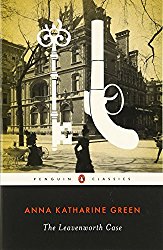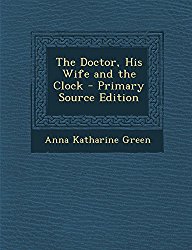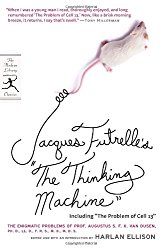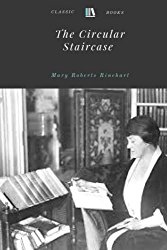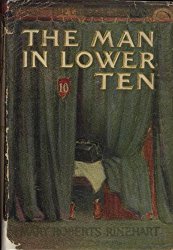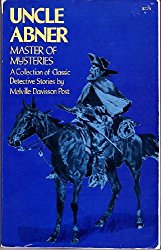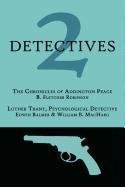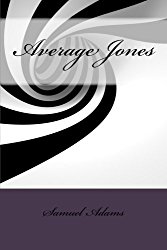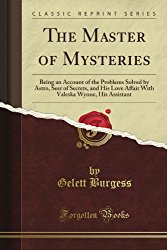The "Romantic" Era:
America: 1890-1914
In England, detective, crime, and murder mystery books continued to achieve high quality. Meanwhile, in America the form was developing as well.
Anna Katharine Green (1846-1935) is the first woman to "practice the form " Howard Haycraft says of her novel The Leavenworth Case (1878), "despite some incredibly bad writing, one of the true historical milestones of the genre." It introduced her police detective Ebenezer Gryce. Her book The Doctor, His Wife, and the Clock is "perhaps the best of the Gryce stories" (Haycraft).
|
Click Image to Click the image below to |
Click Image to |
Anna Katharine Green also created Violet Strange, whom Haycraft says "is best forgotten."
Jacques Futrelle (1875-1912) was a journalist from Boston. He created his detective, "The Thinking Machine." The Thinking Machine's complete name is Augustus S.F.X. Van Dusen, Ph. D., LL. D., F.R.S., M.D., and M.D.S., and he is "dedicated to the blunt proposition that two and two equal four -- not sometimes but all the time."
|
The Thinking Machine stories remain highly readable today. One of the most anthologized stories of all time is "The Problem of Cell Thirteen," which Haycraft tells us is "an unforgettable tour de force that no devotee should miss." (Note: Jacques Futrelle died on the Titanic. Reports indicate that he heroically made sure that others, particularly women and children, were on life boats. He went down with the ship.)
|
Click Image to Click the image below to |
Mary Roberts Rinehart (1876- ) -- whom Haycraft calls "the unquestioned dean of crime writing by and for women" and "one of the great storytellers of the age....Rinehart's works have played an incalculable role in introducing women, both readers and writers, to puzzle fiction." The "Rinehart Formula" was an important contribution to the form.
- The Man in Lower Ten (serially in 1907) (in book form 1909)
- The Circular Staircase (1908). There was a stage version of this written by Rinehart and Avery Hopwood in 1920 called The Bat.
In the stage version, the plot was altered to make the supposed
official detective the culprit. It was made into a silent film, then
later remade as a film version (The Bat (1959 movie) DVD) with Vincent Price, Agnes Moorhead, and Darla Hood.
|
Click Image to Click the image below to |
Click Image to Click the image below to |
Carolyn Wells (b. Rahway, NJ, in the 1870s)created her detective, "Fleming Stone." The first Fleming Stone book was The Clue (Sept. 27, 1909), although Stone appeared earlier in print in a short story in Lippincott's Magazine in 1907). Edmund Wilson quotes Carolyn Wells: "...the detective novel must seem real in the same sense that fairy tales seem real to children" ("Who Cares Who Killed Roger Ackroyd?").
|
Click Image to 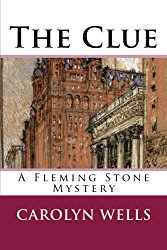 |
Click the image below to |
Detective literature mile-posts
No pun intended on the title of this section, but the following books by Melville Davisson Post (1871-1930) are well worth pursuing -- the Uncle Abner stories are particularly rewarding.
Here are a couple of quotes about Uncle Abner: "Posterity may well name him, after Dupin, the greatest American contribution to the form" (Howard Haycraft, Murder for Pleasure). "One of the truly outstanding figures in detective fiction..." (Willard Huntington Wright in The Great Detective Stories). Wright would rank Uncle Abner with "that immortal triumvirate, Dupin, Lecoq, and Holmes."
|
Click Image to Click the image below to |
Post's other character was the a lawyer named Randolph Mason who was a real scoundrel. (Post himself was a lawyer.)
|
The Complete Uncle Abner stories have been collected into one volume.
Arthur B. Reeve (1880-1936) (full name Arthur Benjamin Reeve) created "Craig Kennedy" (called "the American Sherlock Holmes").
- The Silent Bullet (1912) (a collection of short stories)
Mark Twain (1835-1910)contributed to the genre with his novel Pudd'nhead Wilson (1894), which Howard Haycraft tells us was possibly the first use of fingerprints in fiction. Other Twain books include:
- Huckleberry Finn (some events).
- Tom Sawyer: Detective (burlesque)
Brander Matthews (1852-1929) and Mary E. Wilkins Freeman (1852-1930). Both wrote tales that have been anthologized; neither developed a significant detective. (Read "Shadows on the Wall" by Mary E. Wilkins Freeman.)
Julian Hawthorne (1846-1934) "...was half a century too soon" (says Charles Honce). The son of Nathaniel Hawthorne, Julian wrote poems, novels, short stories, essays, and biographies, including mystery and detective fiction.
Edwin Balmer (1893- ) and William MacHarg (1872- ) wrote The Achievements of Luther Trant (1910), which Haycraft calls "a volume deserving more than passing attention" (Murder for Pleasure). Balmer and MacHarg's story, "The Man Higher Up," contains the first appearance of a lie detector in fiction.
Click Image to
Order from Amazon
(As an Amazon Associate
I earn from
qualifying purchases.)
Samuel Hopkins Adams (1871- )wrote Average Jones (1911). (This is the name of the volume and the name of the detective.) Haycraft says the Average Jones stories are "well above the level of their era, both in conception and style" (Murder for Pleasure).
Click Image to
Order from Amazon
(As an Amazon Associate
I earn from
qualifying purchases.)
Other notable authors and their books of the period include:
- Burton E. Stevenson (1872- ) wrote The Mystery of the Boule Cabinet (1912) .
- John T. McIntyre (1871- ) and his "Ashton Kirk" books (1912) -- see Ashton Kirk Books.
- Gelett Burgess (1866- ) and his The Master of Mysteries (1912). This is the single volume of "Astro" tales.
- Cleveland Moffett (1863-1926) and his book Through the Wall (1909).
Click Image to
Order from Amazon
(As an Amazon Associate
I earn from
qualifying purchases.)
To wrap up this section, I just want to bring to your attention the following authors, who Haycraft says "touched on the fringes...and thus indirectly influenced either the form or the public, or both...":
- C.N. and A.M. Williamson
- H.M. Rideout Harold MacGrath
- Irvin Cobb
- Arthur Train
- Louis Joseph Vance (who wrote about "The Lone Wolf").
- Frank L. Packard (Frank L. Packard Books)
Amazon and the Amazon logo are trademarks of Amazon.com, Inc. or its affiliates.
(This is a link through which I make a small commission if you buy. See here for more details.)
